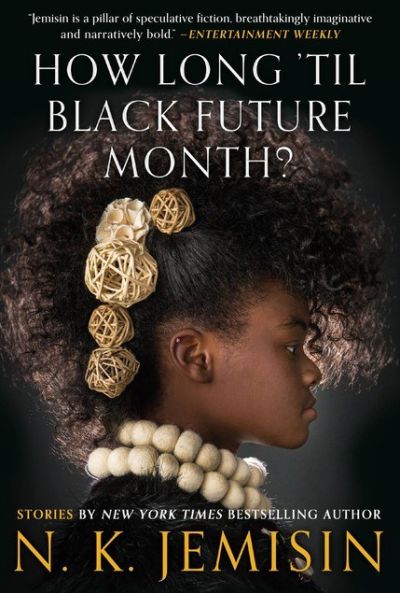Of People Going By
How Long ’til Black Future Month?
By N. K. Jemisin

4 Jan, 2019
0 comments
N. K. Jemisin’s 2018 How Long ’til Black Future Month? is a collection of short stories. It is her first collection of stories. Nota bene: it’s only been out for a month, but that still makes it a 2018 publication and thus eligible for a 2019 Hugo. Just saying.
Although the book is just 400 pages long in hardcover, it includes 23 pieces. Listing and reviewing each of them one by one seems ill-advised. Let’s try the bird’s‑eye view.
Although most of the pieces are fiction, there is one exception, the introduction, which explains just WHY Jemisin bothered to write short fiction.
Those familiar with the state of publishing over the last few decades may wonder why anyone would bother, given that in those days, short-fiction markets paid so little that it would take several sentences to pay for a candy bar. It should also be noted that Jemisin began publishing before epoch-defining events like the Slushbomb, the Great Cultural Appropriation Debates of DOOM, and of course, Racefail, whose tenth anniversary is swift approaching. She couldn’t benefit by increased attention to diversity in publishing when very few people cared (except to hate it). She was climbing uphill, both ways, in the snow. Why would a talented author of color even bother with speculative fiction? Read the introduction to find out1.
How much the field has changed since Jemisin’s first story saw print is hinted by the cover (whose artist I have been unable to identify). It’s not so long ago that Bloomsbury whitewashed the cover of Larbalestier’s Liar, only backing down in the face of protest. SF book covers that did feature black people in the past were often .… regrettable; the reader is invited to look up the ISFDB file for Night of Power on their own time. Black Future’s cover is well executed, but in no way shy about its subject matter.
As for the stories themselves.…
I’m not as well acquainted with the author’s short work as I am with Jemison’s novels2. Many of these stories were brand-new to me. Nor were they all fantasy. Although important elements of the Broken Earth trilogy would not be out of place in a science fiction novel, before this volume I thought of Jemisin as a fantasy author, albeit a hard fantasy author.
In fact, the collection spans a broad range of genres, from urban fantasy to science fiction. There’s just the one essay (which raises the hope there will be a collection of essays) but most everything else is there … and readable to boot. Social justice is a common theme. So is food, for some reason. Like so many people, I see eating as an inconvenience, tolerable only because one needs energy to work. Jemisin revels in descriptions of meals; easily swayed readers may want to keep snacks handy.
Pardon me while I get a snack.
It’s not surprising to see common elements between Jemisin’s stories and stories from the age when gorgonpsids roamed; whatever her gibbering critics might claim, she’s clearly One of Us. At the same time, Jemisin is interested in themes olden time SF might have ignored. Editors of that long-ago time were worried about upsetting their readers. One editor, John W. Campbell, would have been cheering for the other side. But he’s dead and largely forgotten. Who says there’s no progress?
Jemisin’s body of work is one concrete example of the welcome changes in SF in the last few decades. Her slowly accumulating stack of awards shows I am not alone in thinking this.
How Long ’til Black Future Month? is available here (Amazon) and here (Chapters-Indigo).
1: Or read her widely applauded GOH speech.
2: I was lucky enough to be sent the MS of The Hundred Thousand Kingdoms long before it was published. In publishing lingo, I was sent a copy of Nora’s ARC.
